This work collects the contributions presented at the INdAM Workshop “Mathematical modeling and Analysis of degradation and restoration in Cultural Heritage – MACH2019” held in Rome in March 2019. The book is focused on mathematical modeling and simulation techniques with the aim of improving the current strategies of conservation and restoration in cultural heritage, sharing different experiences and approaches. The main topics are: corrosion and sulphation of materials, damage and fractures, stress in thermomechanical systems, contact and adhesion problems, phase transitions and reaction-diffusion models, restoration techniques, additive manufacturing. The final goal is to build a permanent bridge between the experts in cultural heritage and the mathematical community. The work is addressed to experts in cultural heritage and to mathematicians.
